Repetitive Bathing and Skin Poultice with Hydrogen-Rich Water Improve Wrinkles and Blotches Together with Modulation of Skin Oiliness and Moisture
Abstract
:1. Introduction
2. Subjects and Methods
2.1. Preparation of HW Bath
2.2. Treatments with HW Bath and HW Poultice
2.3. Quantitative Assessments for Degrees of Wrinkles and Blotches
2.4. Statistical Analysis
3. Results
3.1. Effect of Improving Wrinkles on Five Subjects by Bathing and Face Poultice with Hydrogen-Rich Warm Water
3.2. Effect of Improving Skin Blotches on Five Subjects by Bathing and Face Poultice with Hydrogen-Rich Warm Water
3.3. Improvements to Oiliness in Five Subjects by Bathing and Face Poultice with Hydrogen-Rich Warm Water
3.4. Improvements to Skin-Moisture Content in Five Subjects by Bathing or Face Poultice with Hydrogen-Rich Warm Water
4. Discussion
5. Conclusions
Author Contributions
Funding
Institutional Review Board Statement
Informed Consent Statement
Acknowledgments
Conflicts of Interest
References
- Akitomo, Y.; Akamatsu, H.; Okano, Y.; Masaki, H.; Horio, T. Effects of UV irradiation on the sebaceous gland and sebum secretion in hamsters. J. Dermatol. Sci. 2003, 31, 151–159. [Google Scholar] [CrossRef]
- Colavitti, R.; Finkel, T. Reactive Oxygen Species as Mediators of Cellular Senescence. IUBMB Life 2005, 57, 277–281. [Google Scholar] [CrossRef] [PubMed]
- Pageon, H. Reaction of glycation and human skin: The effects on the skin and its components, reconstructed skin as a model. Pathol. Biol. 2010, 58, 226–231. [Google Scholar] [CrossRef] [PubMed]
- Schieber, M.; Chandel, N.S. ROS Function in Redox Signaling and Oxidative Stress. Curr. Biol. 2014, 24, R453–R462. [Google Scholar] [CrossRef] [PubMed] [Green Version]
- Gu, Y.; Han, J.; Jiang, C.; Zhang, Y. Biomarkers, oxidative stress and autophagy in skin aging. Ageing Res. Rev. 2020, 59, 101036. [Google Scholar] [CrossRef] [PubMed]
- Lim, H.Y.; Jeong, D.; Park, S.H.; Shin, K.K.; Hong, Y.H.; Kim, E.; Yu, Y.G.; Kim, T.R.; Kim, H.; Lee, J.; et al. Antiwrinkle and Antimelanogenesis Effects of Tyndallized Lactobacillus acidophilus KCCM12625P. Int. J. Mol. Sci. 2020, 21, 1620. [Google Scholar] [CrossRef] [Green Version]
- Rasul, A.; Akhtar, N. Formulation and in vivo evaluation for anti-aging effects of an emulsion containing basil extract using non-invasive biophysical techniques. DARU J. Fac. Pharm. Tehran Univ. Med. Sci. 2011, 19, 344–350. [Google Scholar]
- Seo, H.; Kim, C.; Kim, M.B.; Hwang, J.K. Anti-Photoaging Effect of Korean Mint (Agastache rugosa Kuntze) Extract on UVB-Irradiated Human Dermal Fibroblasts. Prev. Nutr. Food Sci. 2019, 24, 442–448. [Google Scholar] [CrossRef]
- Lorz, L.R.; Yoo, B.C.; Kim, M.Y.; Cho, J.Y. Anti-Wrinkling and Anti-Melanogenic Effect of Pradosia mutisii Methanol Extract. Int. J. Mol. Sci. 2019, 20, 1043. [Google Scholar] [CrossRef] [Green Version]
- An, M.; Kim, H.; Moon, J.M.; Ko, H.S.; Clayton, P.; Lim, Y.H. Enzyme-Treated Zizania latifolia Ethanol Extract Protects from UVA Irradiation-Induced Wrinkle Formation via Inhibition of Lysosome Exocytosis and Reactive Oxygen Species Generation. Antioxidants 2020, 9, 912. [Google Scholar] [CrossRef]
- Kaur, C.D.; Saraf, S. Topical vesicular formulations of Curcuma longa extract on recuperating the ultraviolet radiation-damaged skin. J. Cosmet. Dermatol. 2011, 10, 260–265. [Google Scholar] [CrossRef] [PubMed]
- Asada, R.; Saitoh, Y.; Miwa, N. Effects of Hydrogen-Rich Water Bath on Visceral Fat and Skin Blotch, with Boiling-Resistant Hydrogen Bubbles. Med. Gas Res. 2019, 9, 68–73. [Google Scholar] [CrossRef] [PubMed]
- Tanaka, Y.; Xiao, L.; Miwa, N. Hydrogen-rich bath with nano-sized bubbles improves antioxidant capacity based on oxygen radical absorbing and inflammation levels in human serum. Med. Gas Res. 2022, 12, 91–99. [Google Scholar] [CrossRef] [PubMed]
- Jensen, G.S.; Shah, B.; Holtz, R.; Patel, A.; Lo, D.C. Reduction of facial wrinkles by hydrolyzed water-soluble egg membrane associated with reduction of free radical stress and support of matrix production by dermal fibroblasts. Clin. Cosmet. Investig. Dermatol. 2016, 9, 357–366. [Google Scholar] [CrossRef] [Green Version]
- Huang, C.S.; Kawamura, T.; Toyoda, Y.; Nakao, A. Recent Advances in Hydrogen Research as a Therapeutic Medical Gas. Free. Radic. Res. 2010, 44, 971–982. [Google Scholar] [CrossRef]
- LeBaron, T.W.; Kura, B.; Kalocayova, B.; Tribulova, N.; Slezak, J. A New Approach for the Prevention and Treatment of Cardiovascular Disorders. Molecular Hydrogen Significantly Reduces the Effects of Oxidative Stress. Molecules 2019, 24, 2076. [Google Scholar] [CrossRef] [Green Version]
- Nakao, A.; Toyoda, Y.; Sharma, P.; Evans, M.; Guthrie, N. Effectiveness of Hydrogen Rich Water on Antioxidant Status of Subjects with Potential Metabolic Syndrome—An Open Label Pilot Study. J. Clin. Biochem. Nutr. 2010, 46, 140–149. [Google Scholar] [CrossRef] [Green Version]
- Hirano, S.I.; Ichikawa, Y.; Sato, B.; Yamamoto, H.; Takefuji, Y.; Satoh, F. Molecular Hydrogen as a Potential Clinically Applicable Radioprotective Agent. Int. J. Mol. Sci. 2021, 22, 4566. [Google Scholar] [CrossRef]
- Kato, S.; Saitoh, Y.; Iwai, K.; Miwa, N. Hydrogen-rich electrolyzed warm water represses wrinkle formation against UVA ray together with type-I collagen production and oxidative-stress diminishment in fibroblasts and cell-injury prevention in keratinocytes. J. Photochem. Photobiol. B Biol. 2012, 106, 24–33. [Google Scholar] [CrossRef]
- Kim, D.; Hu, R.; Fan, Y.; Xu, Y.N.; Park, H.J.; Lee, S.K. Photoprotective effects of 2S,3R-6-methoxycarbonylgallocatechin isolated from Anhua dark tea on UVB-induced inflammatory responses in human keratinocytes. J. Photochem. Photobiol. B Biol. 2020, 202, 111704. [Google Scholar] [CrossRef]
- Wen, S.Y.; Chen, J.Y.; Chen, C.J.; Huang, C.Y.; Kuo, W.W. Protective effects of galangin against H2O2—Induced aging via the IGF-1 signaling pathway in human dermal fibroblasts. Environ. Toxicol. 2020, 35, 115–123. [Google Scholar] [CrossRef]
- Chatatikun, M.; Chiabchalard, A. Thai plants with high antioxidant levels, free radical scavenging activity, anti-tyrosinase and anti-collagenase activity. BMC Complement. Altern. Med. 2017, 17, 487. [Google Scholar] [CrossRef] [Green Version]
- Lee, Y.; Lim, H.W.; Ryu, I.W.; Huang, Y.H.; Park, M.; Chi, Y.M.; Lim, C.J. Anti-Inflammatory, Barrier-Protective, and Antiwrinkle Properties of Agastache rugosa Kuntze in Human Epidermal Keratinocytes. BioMed Res. Int. 2020, 2020, 1759067. [Google Scholar] [CrossRef]
- Yoshikawa, M.; Okano, Y.; Masaki, H. An Ocimum basilicum Extract Containing Rosmarinic Acid Restores the Disruption of Collagen Fibers Caused by Repetitive UVA Irradiation of Dermal Fibroblasts. J. Oleo Sci. 2020, 69, 1487–1495. [Google Scholar] [CrossRef]
- Park, D.J.; Sekhon, S.S.; Yoon, J.; Kim, Y.H.; Min, J. Color reduction of melanin by lysosomal and peroxisomal enzymes isolated from mammalian cells. Mol. Cell. Biochem. 2016, 413, 119–125. [Google Scholar] [CrossRef] [PubMed]
- Bow, J.R.; Sonoki, Y.; Uchiyama, M.; Dauskardt, R.H. Ectoine disperses keratin and alters hydration kinetics in stratum corneum. Biochem. Biophys. Rep. 2021, 28, 101134. [Google Scholar] [CrossRef] [PubMed]
- Kim, E.; Hwang, K.; Lee, J.; Han, S.Y.; Kim, E.M.; Park, J.; Cho, J.Y. Skin Protective Effect of Epigallocatechin Gallate. Int. J. Mol. Sci. 2018, 19, 173. [Google Scholar] [CrossRef] [PubMed] [Green Version]
- Teng, W.L.; Huang, P.H.; Wang, H.C.; Tseng, C.H.; Yen, F.L. Pterostilbene Attenuates Particulate Matter-Induced Oxidative Stress, Inflammation and Aging in Keratinocytes. Antioxidants 2021, 10, 1552. [Google Scholar] [CrossRef]
- Feru, J.; Delobbe, E.; Ramont, L.; Brassart, B.; Terryn, C.; Dupont-Deshorgue, A.; Garbar, C.; Monboisse, J.C.; Maquart, F.X.; Brassart-Pasco, S. Aging decreases collagen IV expression in vivo in the dermo-epidermal junction and in vitro in dermal fibroblasts: Possible involvement of TGF-beta1. Eur. J. Dermatol. 2016, 26, 350–360. [Google Scholar] [CrossRef]
- Tsujimoto, H.; Hara, K.; Tsukada, Y.; Huang, C.C.; Kawashima, Y.; Arakaki, M.; Okayasu, H.; Mimura, H.; Miwa, N. Evaluation of the permeability of hair growing ingredient encapsulated PLGA nanospheres to hair follicles and their hair growing effects. Bioorg. Med. Chem. Lett. 2007, 17, 4771–4777. [Google Scholar] [CrossRef]
- Kato, S.; Saitoh, Y.; Miwa, N. Inhibitions by hydrogen-occluding silica microcluster to melanogenesis in human pigment cells and tyrosinase reaction. J. Nanosci. Nanotechnol. 2013, 13, 52–59. [Google Scholar] [CrossRef] [PubMed]
- Xiao, L.; Miwa, N. Hydrogen Nano-Bubble Water Suppresses ROS Generation, Adipogenesis, and Interleukin-6 Secretion in Hydrogen-Peroxide- or PMA-Stimulated Adipocytes and Three-Dimensional Subcutaneous Adipose Equivalents. Cells 2021, 10, 626. [Google Scholar] [CrossRef] [PubMed]
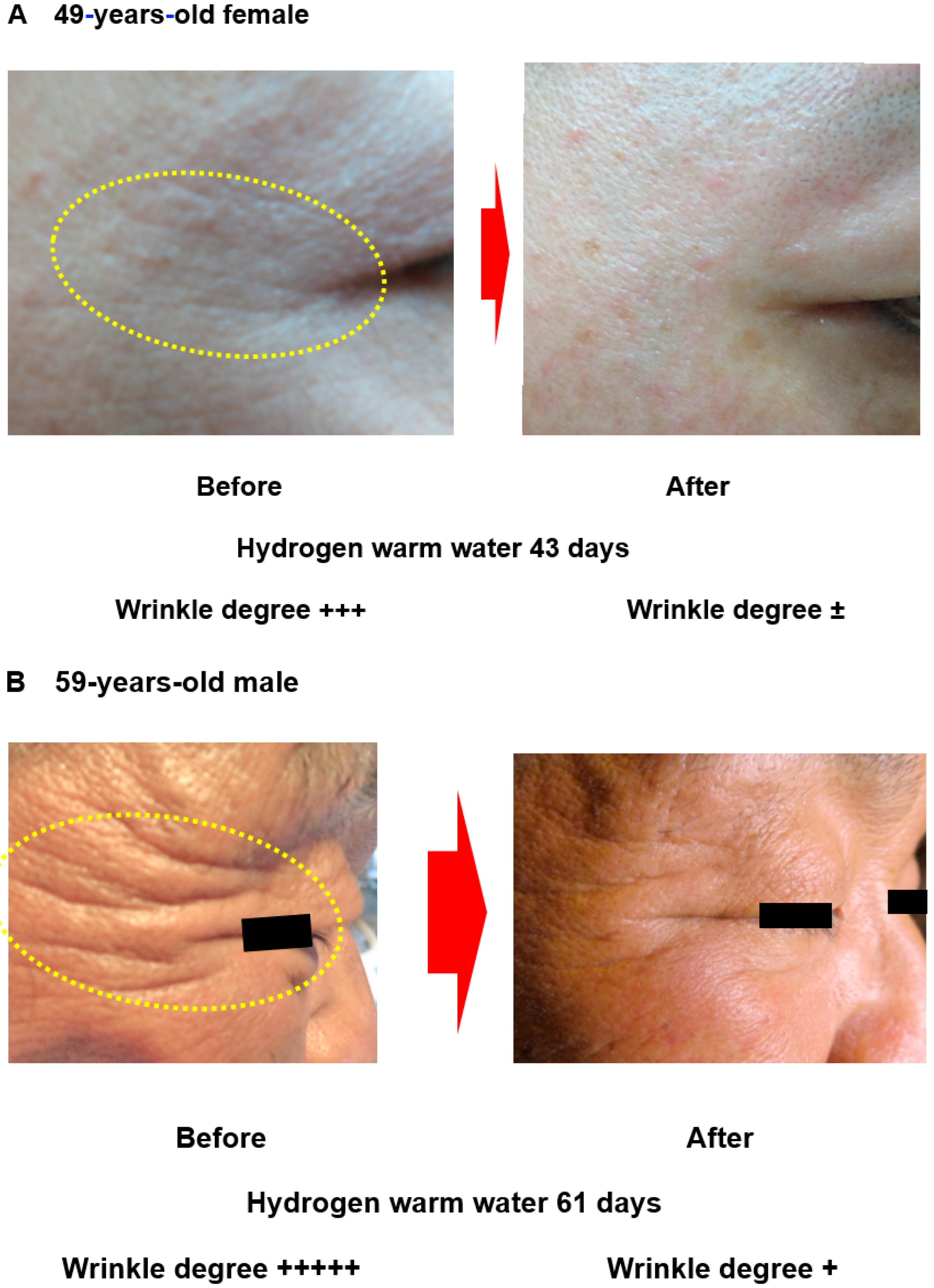
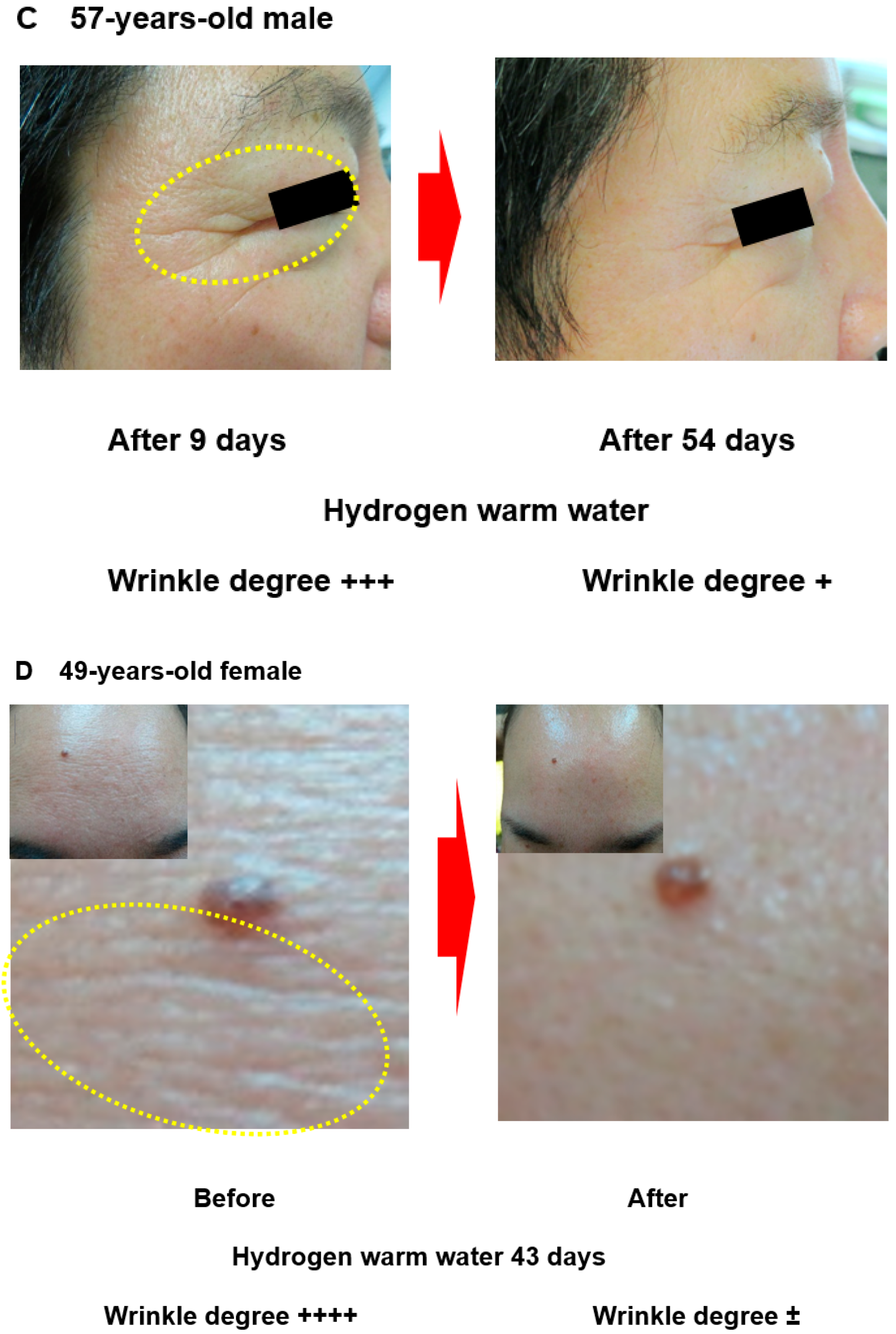
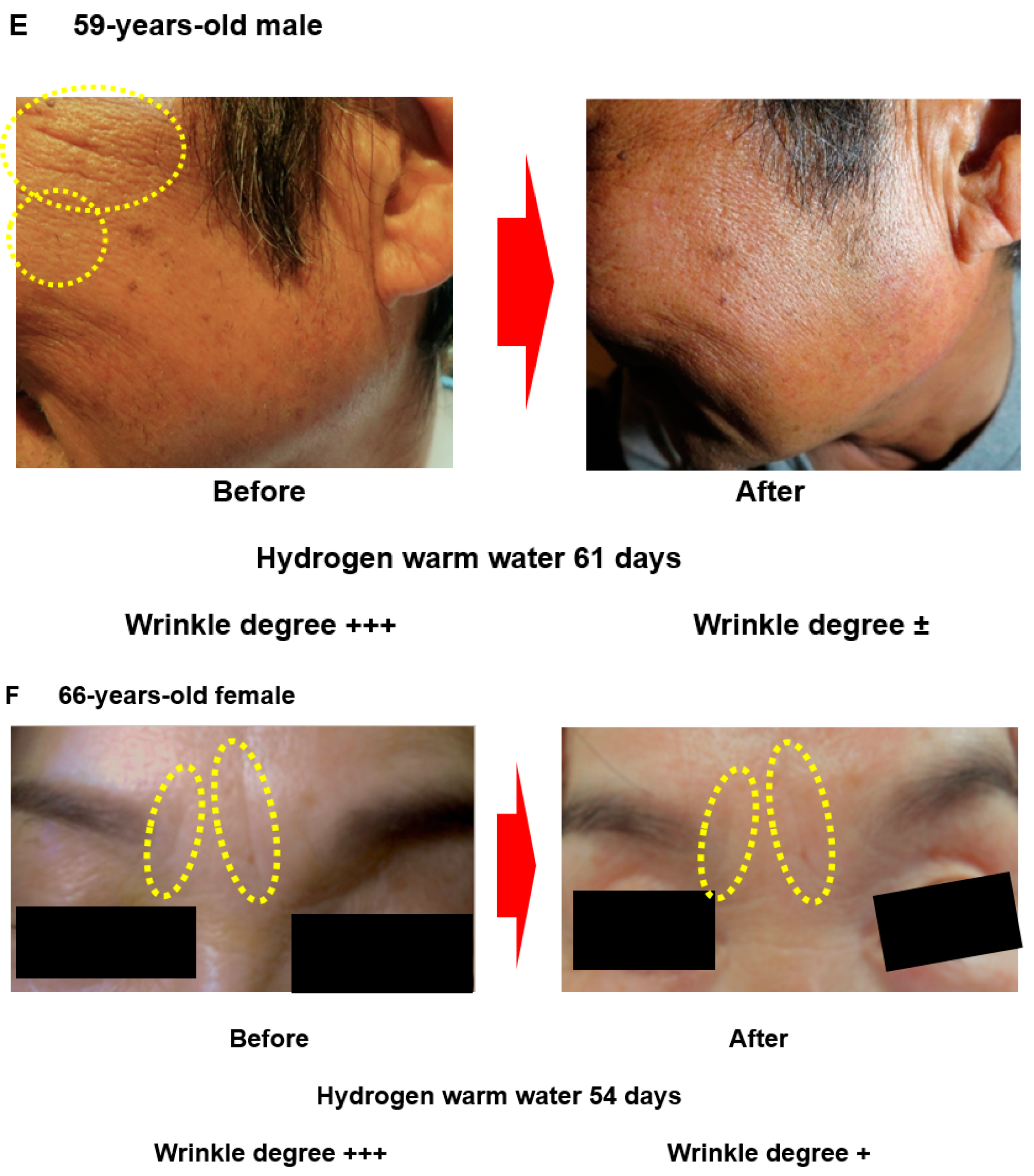
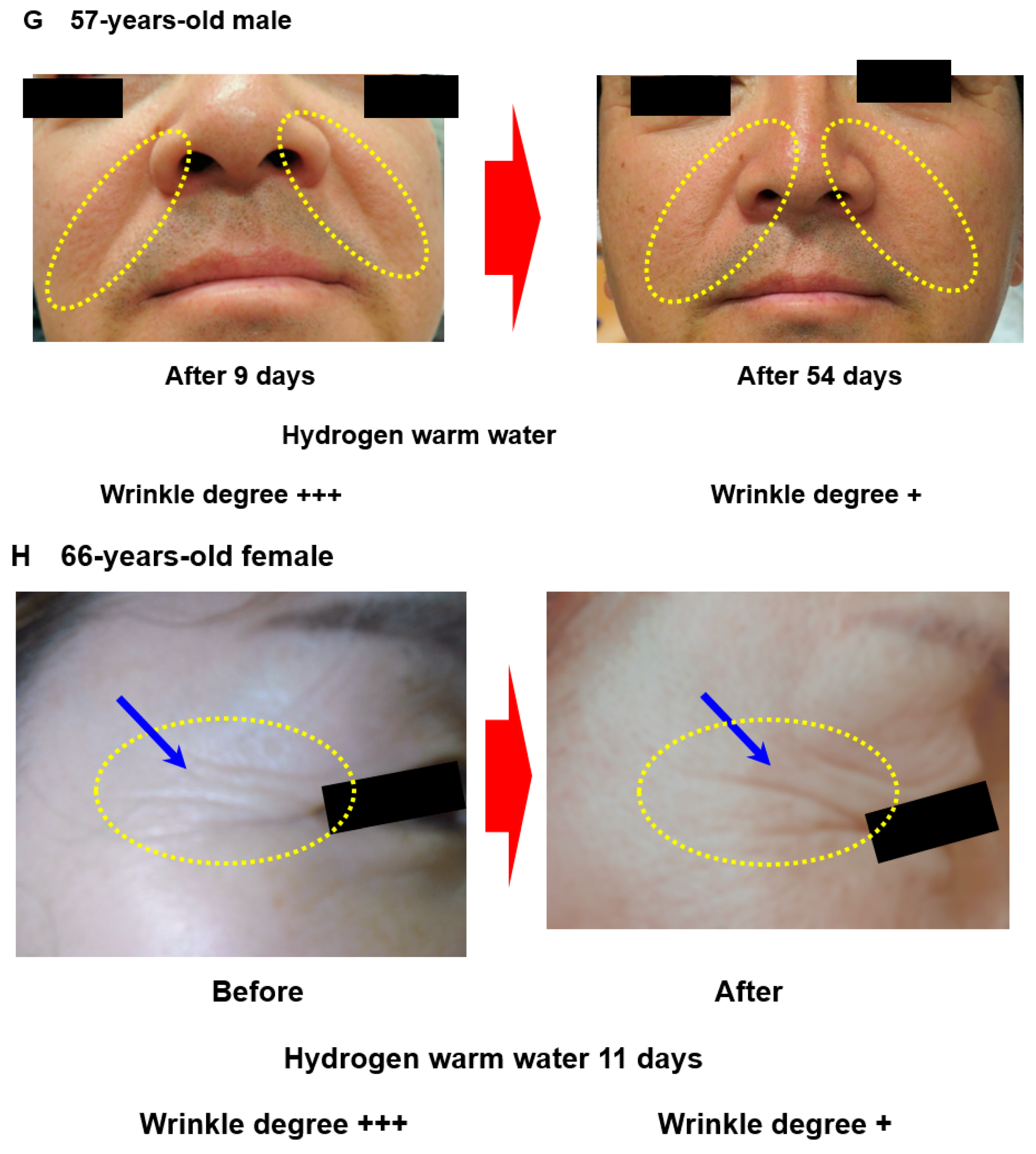
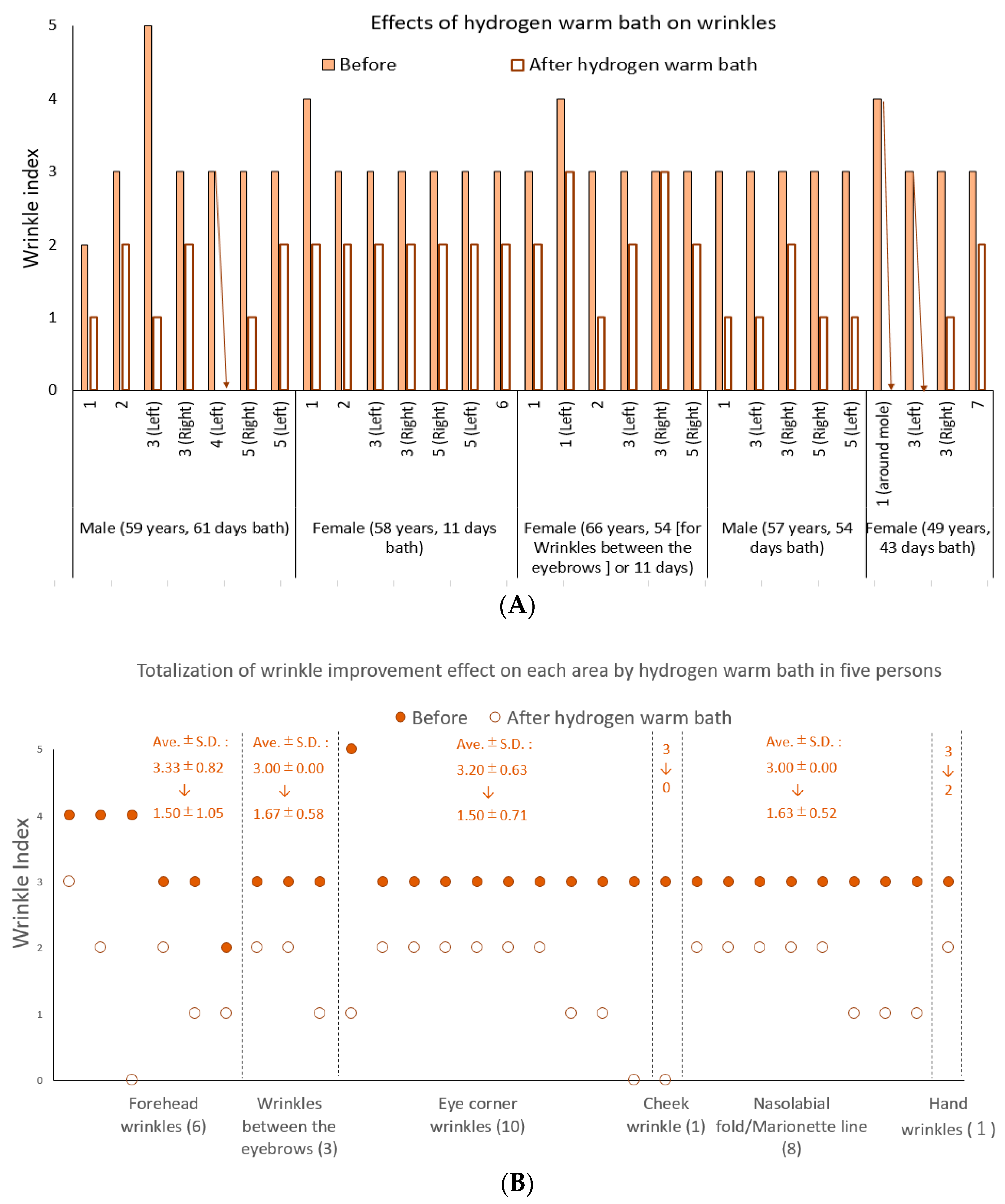
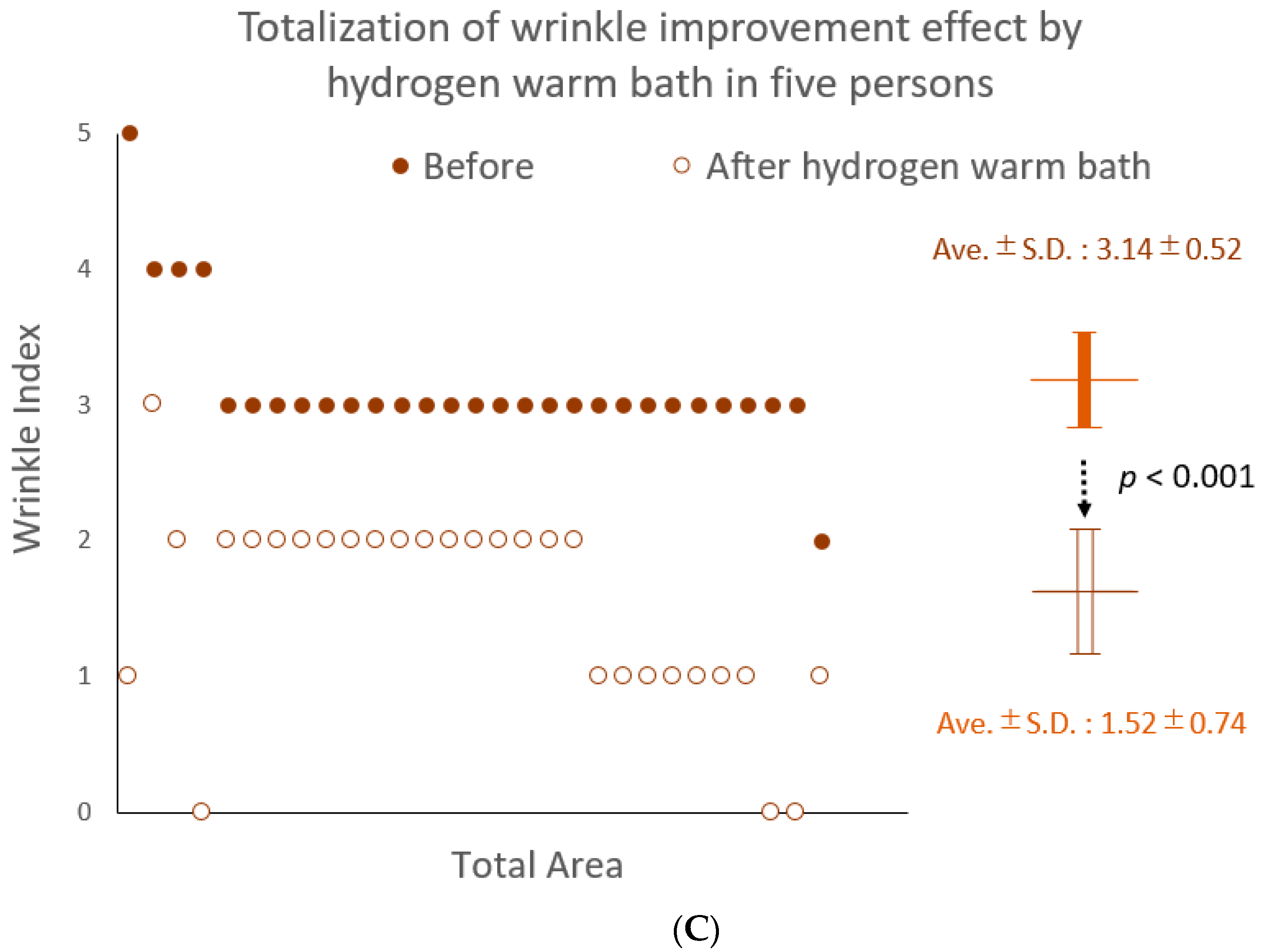
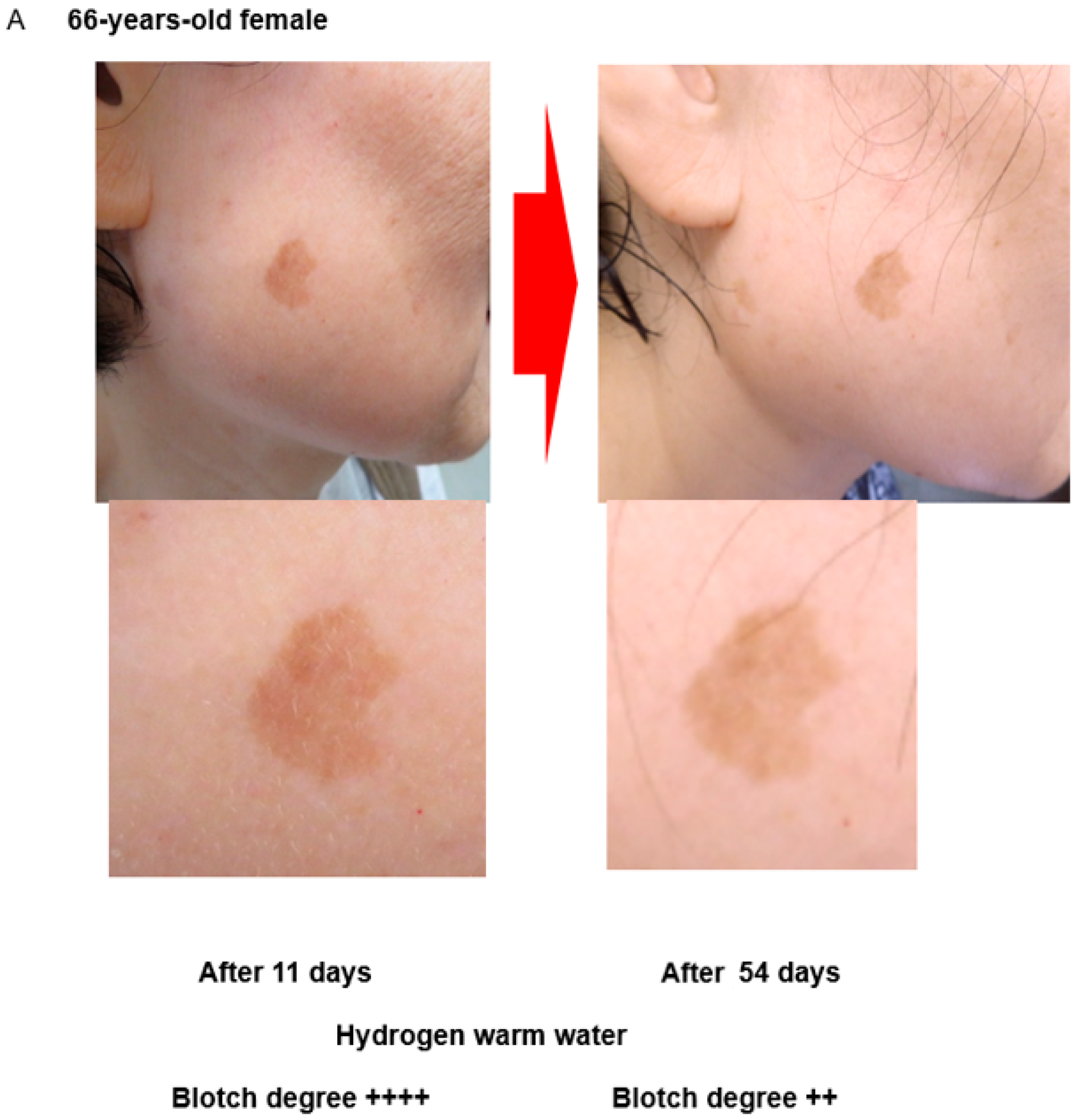
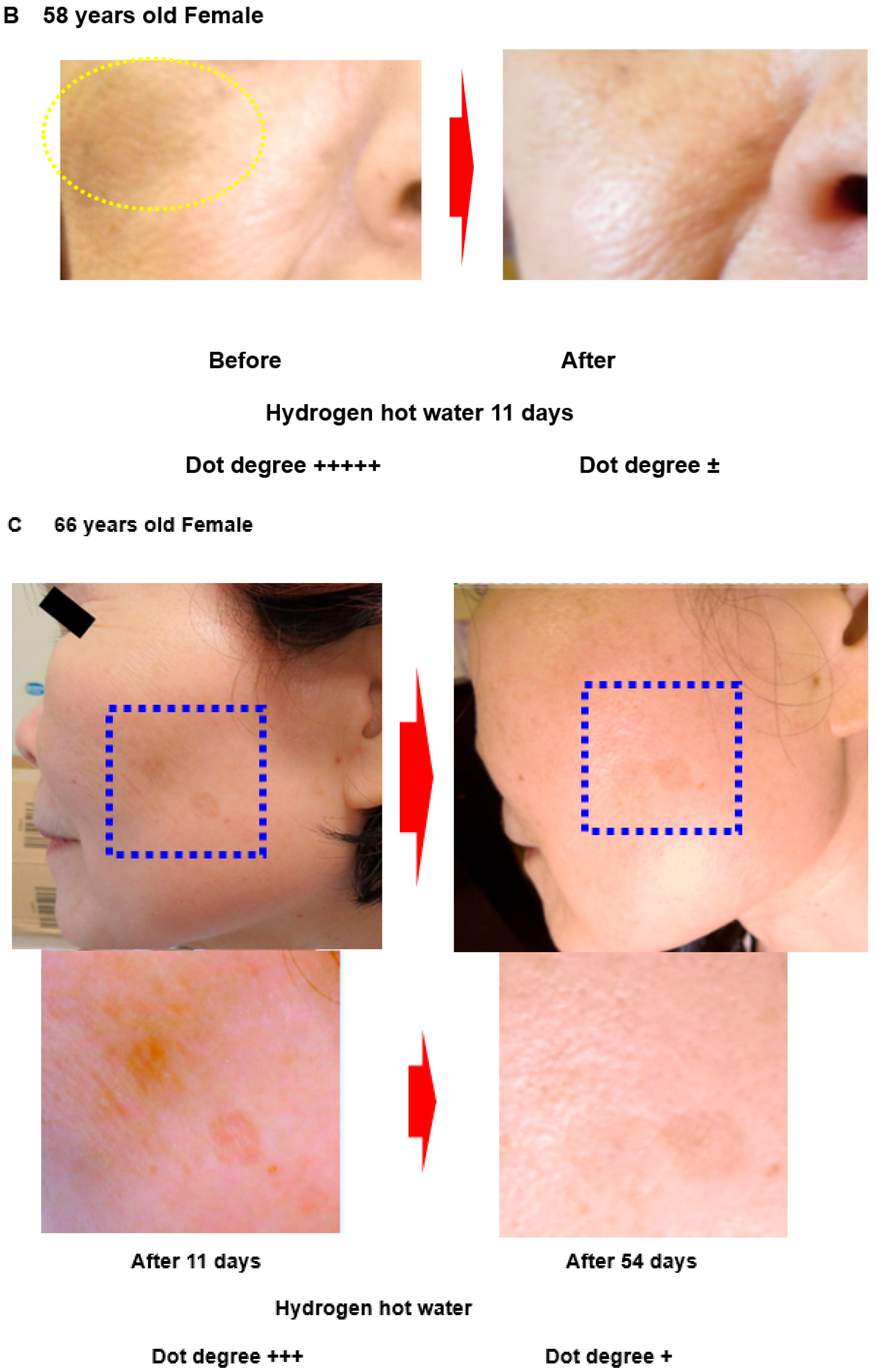
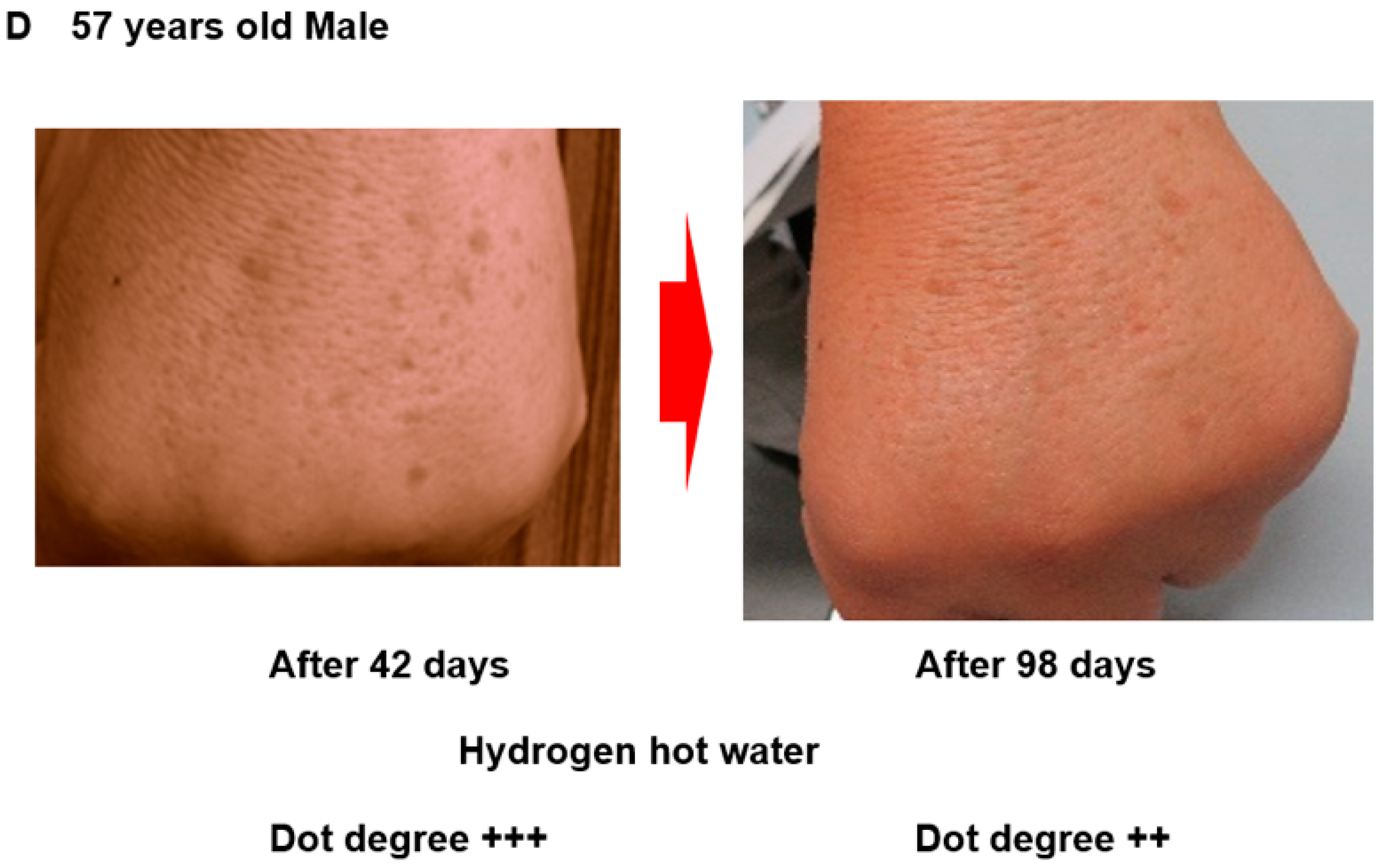
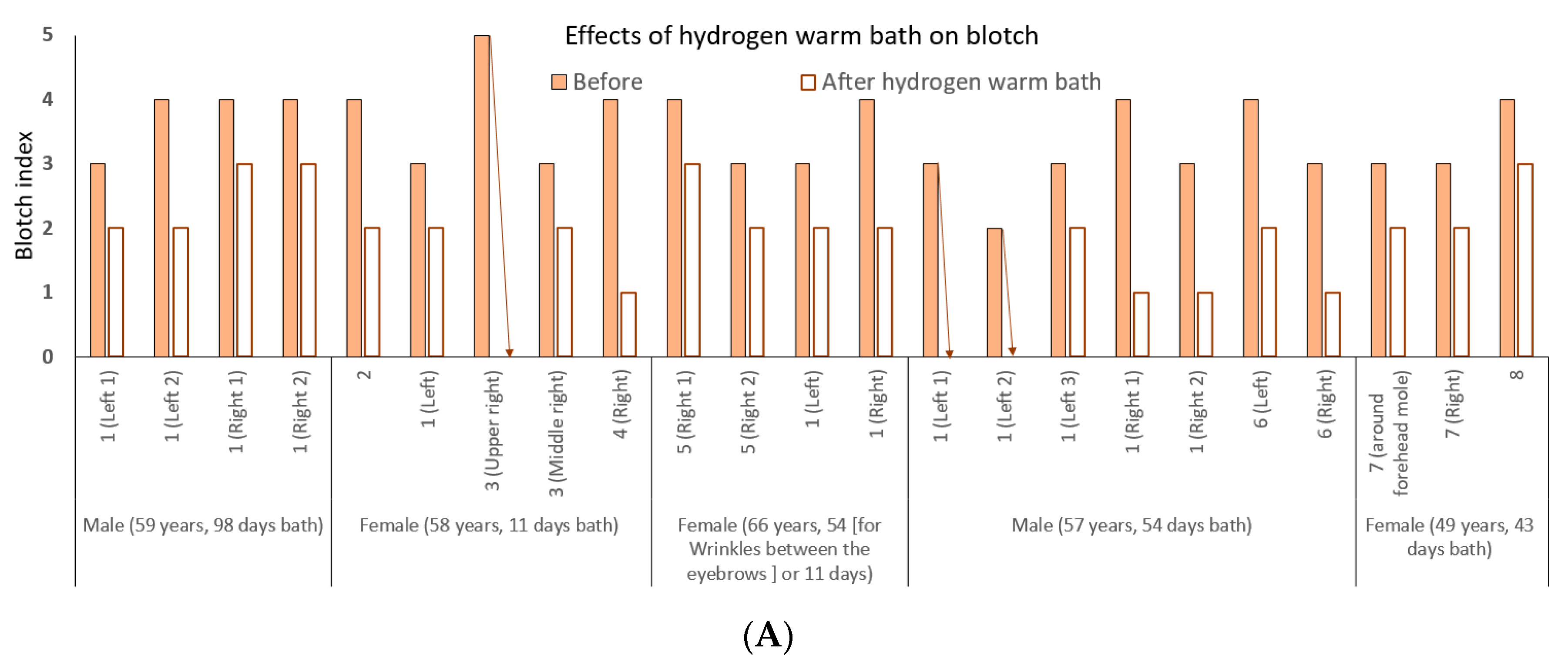
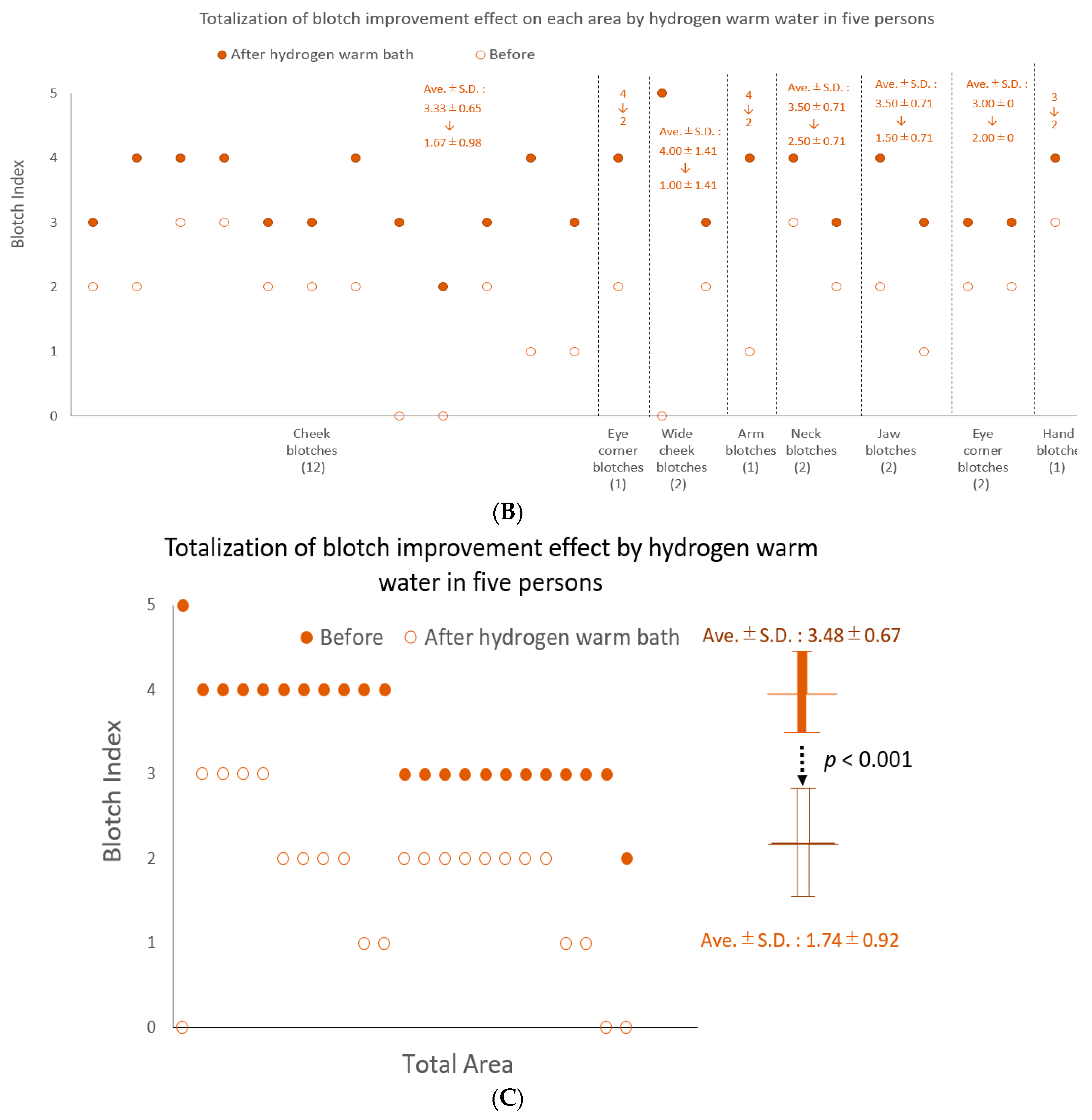
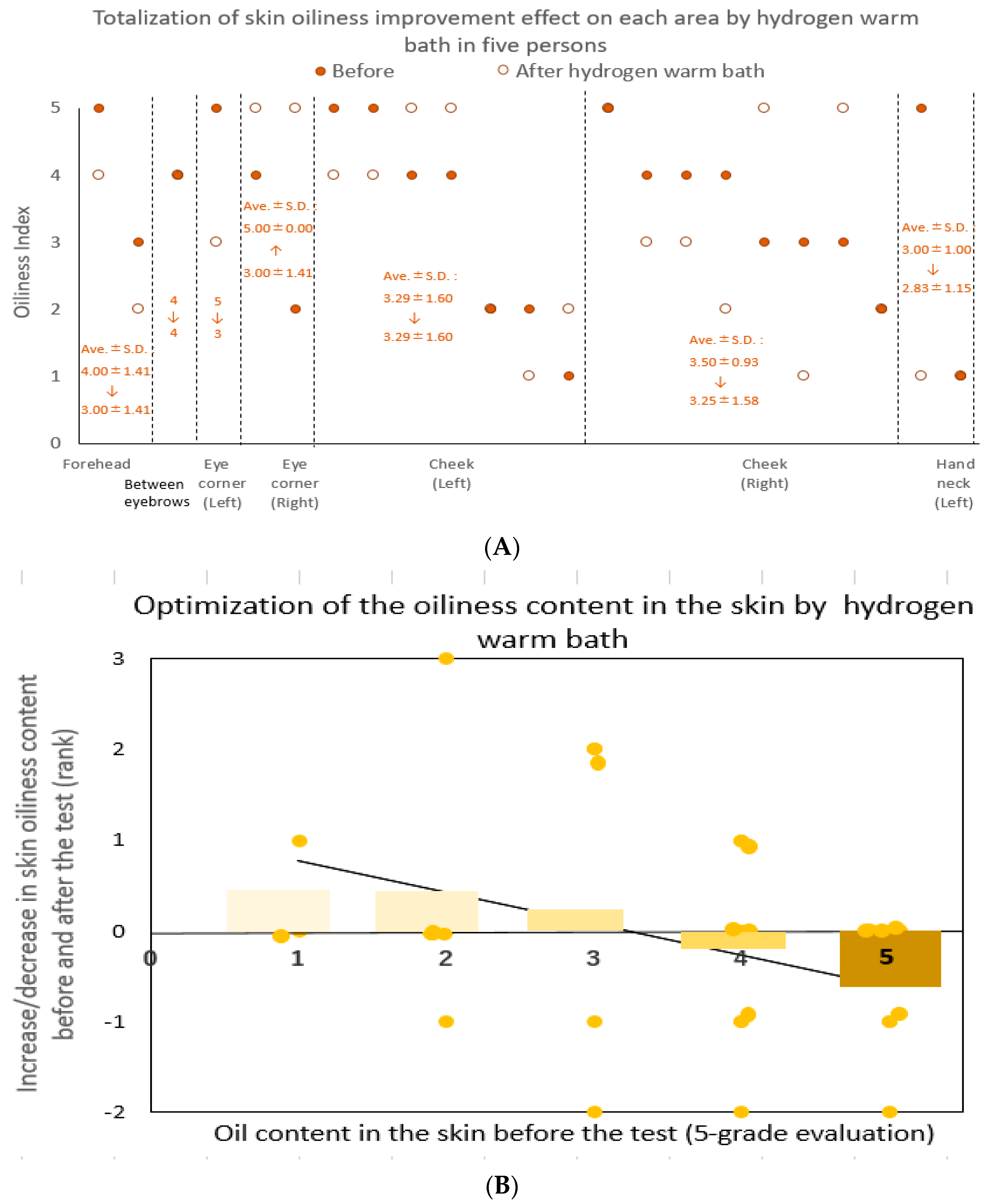
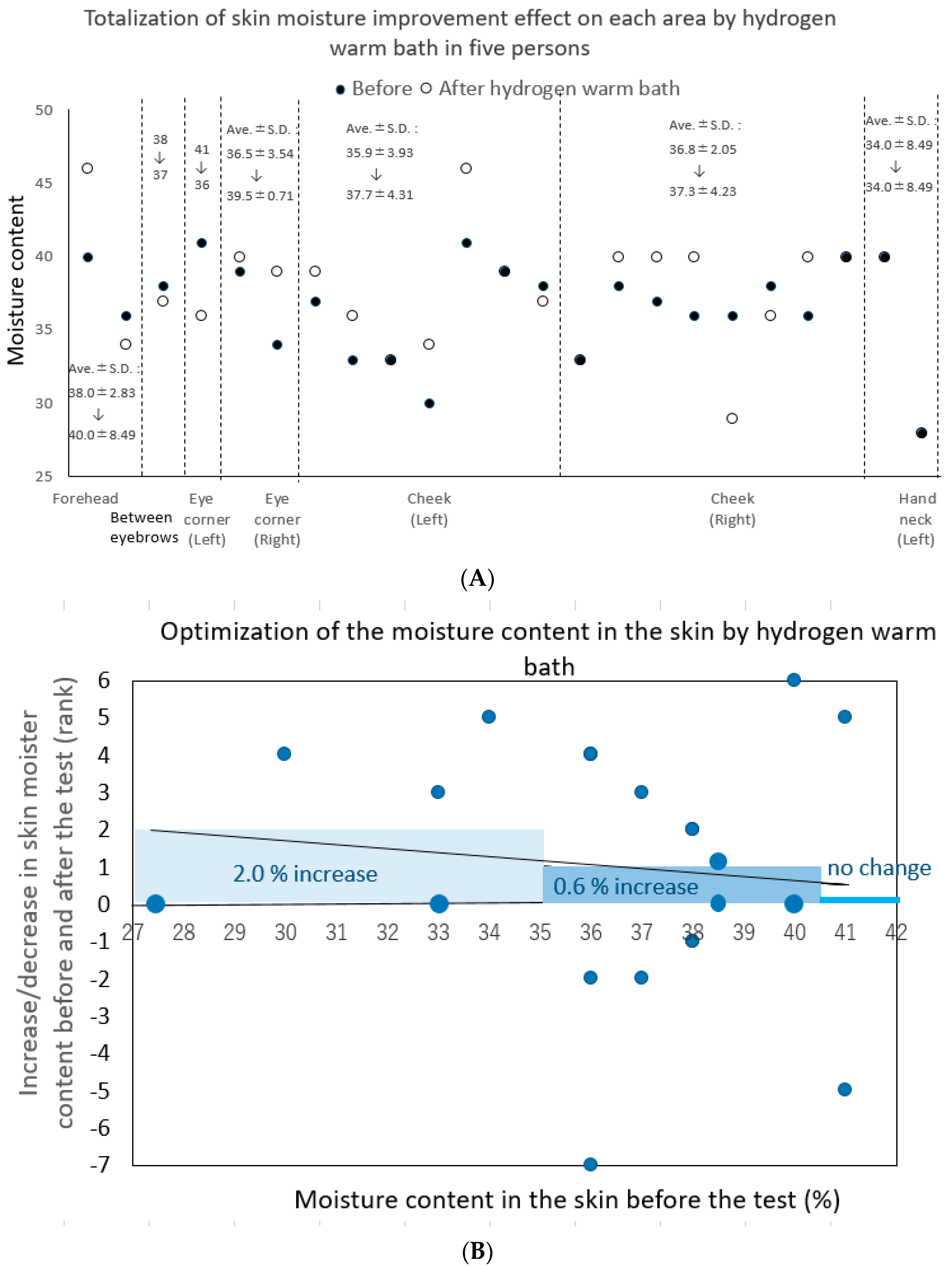
Publisher’s Note: MDPI stays neutral with regard to jurisdictional claims in published maps and institutional affiliations. |
© 2022 by the authors. Licensee MDPI, Basel, Switzerland. This article is an open access article distributed under the terms and conditions of the Creative Commons Attribution (CC BY) license (https://creativecommons.org/licenses/by/4.0/).
Share and Cite
Tanaka, Y.; Miwa, N. Repetitive Bathing and Skin Poultice with Hydrogen-Rich Water Improve Wrinkles and Blotches Together with Modulation of Skin Oiliness and Moisture. Hydrogen 2022, 3, 161-178. https://doi.org/10.3390/hydrogen3020011
Tanaka Y, Miwa N. Repetitive Bathing and Skin Poultice with Hydrogen-Rich Water Improve Wrinkles and Blotches Together with Modulation of Skin Oiliness and Moisture. Hydrogen. 2022; 3(2):161-178. https://doi.org/10.3390/hydrogen3020011
Chicago/Turabian StyleTanaka, Yoshiharu, and Nobuhiko Miwa. 2022. "Repetitive Bathing and Skin Poultice with Hydrogen-Rich Water Improve Wrinkles and Blotches Together with Modulation of Skin Oiliness and Moisture" Hydrogen 3, no. 2: 161-178. https://doi.org/10.3390/hydrogen3020011
APA StyleTanaka, Y., & Miwa, N. (2022). Repetitive Bathing and Skin Poultice with Hydrogen-Rich Water Improve Wrinkles and Blotches Together with Modulation of Skin Oiliness and Moisture. Hydrogen, 3(2), 161-178. https://doi.org/10.3390/hydrogen3020011





